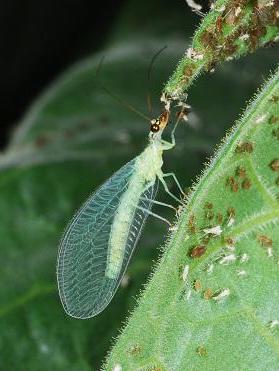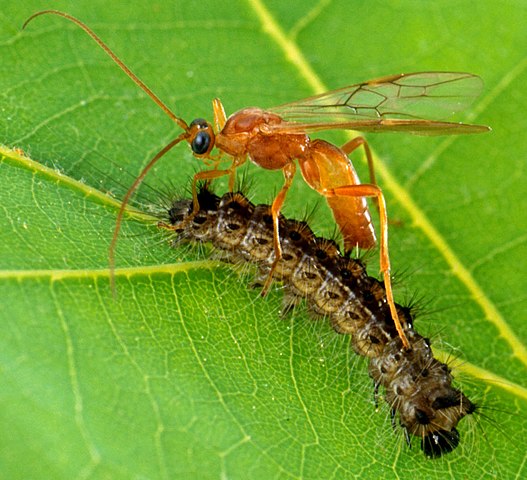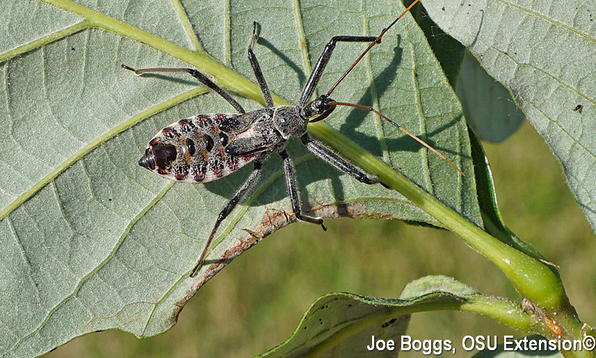Nature’s Pest Control: Beneficial Insects
By Janet Scheren, Fairfax Master Gardener

Adult lacewing
We learn time and time again that when we disturb nature, humans have to take on critical services previously performed by wildlife. One example is the beaver — the best wetland engineer – far better even than man. Their work in the forest improves water quality, reduces floods and increases biodiversity and abundance of fish and other forest dwellers. They also gnaw and cut through trees to open tree canopies, allowing more sunlight deep into the forest, and again improving biological diversity. And they perform all these important services without costing homeowners or taxpayers a dime!
In our yards and garden, think of having a wide array of beneficial insects as essential garden workers. They can help to maintain an ecological balance and perform key tasks. In addition to serving as pollinators — a critical role in forming fruit (including vegetables such as squash, tomatoes, beans and peppers) and berries — they defend against insect pests. They also attract birds into your yard, which also help to keep insect pests under control.
The greatest service beneficial insects provide, however, is the control of plant-feeding insects by insect predators and parasitoids. Ladybugs, lacewings, assassin bugs and dragonflies are good examples of predators. Parasitoids perform their services by living in or on the bodies of other insects. Parasitoid wasps are among the most common parasitoids found in our gardens.
Among the predatory and parasitotic beneficial insects are the following.
- Assassin Bug — have a wide variety of prey including flies, caterpillars, beetles and mosquitoes. They are particularly valuable for killing squash vine borers on cucumbers, squash and pumpkins in the vegetable garden.
- Dragonflies — eat small midges, gnats and mosquitos
- Fireflies — their larvae feed on smaller insects, slugs and snails
- Green Lacewing — eat aphids, scales, mealybugs, thrips, mites and insect eggs
- Ladybugs — feed mostly on aphids, but also eat scale insects and mealybugs
- Parasitoid Wasps — control the populations of many insects, including many caterpillars and tomato hornworms
- Predaceous Stink Bug — unlike the common brown marmorated stink bug, these stink bugs eat more than 100 species of insect pests. The predatory stink bugs tend to have shorter, stouter beaks than the long, thin beaks of plant-feeding stink bugs. If you watch what they do in the garden, you’ll be able to tell which you have.
- Trichogramma Wasp — these minute, almost microscopic wasps parasitize the eggs of other insects. They are used in the pest management of tens of millions of acres of crop and forest land around the world each year, yet they are harmless to humans.
The list of pollinators is almost endless. It includes native bees, butterflies, moths, bumble bees, as well as non-insects — bats, hummingbirds, beetles and many more.

Parasitic mummy wasp & gypsy moth caterpillar
Unfortunately, large expanses of monocultural lawns framed by non-flowering shrubs and trees, all treated with a wide array of sprays, granules and powders, is incompatible with these busy garden workers. And it’s not very healthy for members of our households or local wildlife either.
The questions then become: How do you know which insects are beneficial, how do we create a healthy environment for them and how do we attract them? The answer is much simpler than you may think: Build a healthy ecosystem — full of flowers and devoid of pesticides and herbicides — and they will come. Yes, it’s really that simple. But it does take some time and patience.
Start by improving your garden with organic matter as a foundation for plant and soil health.
Look to natural methods of controlling pests such as aphids and Japanese beetles to give beneficial insects a chance to take over this role. For example, use a spray of water from a hose to remove aphids, and shake Japanese beetles into a jar of soapy water to remove and kill them. As a sidenote, aphids are often attracted to plants that have been treated with an overabundance of nitrogen fertilizer, so cutting back on non-organic and even excessive organic fertilizer helps as well.

Assassin Bug
Add a lot of flowering plants to your yard. Fruit and vegetable gardens should be about 40 percent flowering plants. Be sure to add masses of flowers to your landscapes as well. If you don’t have enough sun around your foundation, add beds or borders elsewhere in your yard. For smaller yards or townhomes, add flowers in pots or window boxes.
Among the best flowers to attract and support beneficial insects are zinnias, marigolds, salvia and sages, as well as nicotiana, calendula, lavender, cosmos, delphinium, hollyhock, larkspur, bee balm and flowering herbs. Plant a wide variety of flower shapes and colors to accommodate a wide variety of beneficial insects. Plan a succession of blooms from early spring through late fall to keep these hard-working members of the insect family on your site. Early bulbs and native tuberous perennials, such as snow drops, early daffodils, grape hyacinth, woodland crocus and Virginia springbeauty Claytonia virginica can provide early spring forage.
Perennials, shrubs and trees can also enhance your ability to attract beneficial insects and provide early forage year after year — flowering fruit trees, hawthorn, redbud, maple, elm, poplar, willow, forsythia and witch hazel.
Other considerations such as garden maintenance and sanitation are also key factors in keeping your plants disease free and healthy. Healthy plants are much more resistant to insect pests. These bad bugs look for weak and sickly plants as easy prey. Use chemicals — fungicides and pesticides — only as a last resort and work toward building a healthy garden that doesn’t require chemical intervention at all. When using a chemical control, always fully read and follow labeling directions, including how often the product can be applied.
Resources
• Four Beneficial Insects as Babies, Ann M. Mason, Fairfax Gardening
• Beneficial Insects, Virginia Cooperative Extension
• Vegetables Love Flowers, by Lisa Mason Ziegler
• Bee Friendly Flowers, Charlotte Glen, Horticulture Agent, North Carolina State University Extension
• Basic Entomology, Theresa Dellinger and Eric Day, Virginia Cooperative Extension, Master Gardener
Handbook, Chapter 5
• Predatory Stink Bugs, Mike Raupp, Jon Traunfeld and Chris Sargent, University of Maryland Extension
• Trichogramma Wasp, David Orr, Entomology — Insect Biology and Management, North Carolina State
University Extension